3 Empires activities
1. Interpreting Venetian art: Source analysis
Connor Beaumont
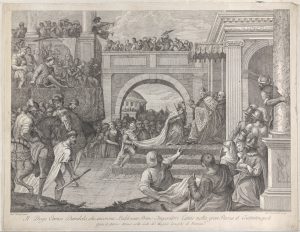
Doge Enrico Dandolo crowns Baldovino the first emperor of the Latin Empire of Constantinople 1745–94, The MET Museum, Public Domain
| Curriculum context | Unit 2 Empires Area of Study 2 (VCAA, 2020) |
| Historical thinking concept/s | Use sources as evidence
Explore historical perspectives |
| Historical context | The Venetian Republic |
| Learning intentions | Use questions to practise source analysis
Identify perspectives and social factors, values and representations in the source and evaluate their historical significance |
Activity
Historians utilise and examine a range of sources as articles of history, not just literature and documents, but artwork from the period. Your task is to answer the questions below, using the two artworks provided and these guiding questions:
- When was the source made and by by who?
- Describe the content of the source.
- Who is represented in the source? How are they represented?
- What was happening socially/ politically at the time the source was made?
- What is the purpose of the source? Who is the target audience?
- What can be inferred about the socio-economic state of Venice at the time, based on the sources provided?
- What can be inferred about the socio-political state of Venice at the time, based on the sources provided?
Source A: ‘The Quack* Dentist,’ Plate 9 from Selection of Pictures from Venetian Collections, by Giacomo Leonardis, 1765. OA, The Metropolitan Museum of Art, Public Domain

Inscription:
“Now with his voice, now with his hand
Now money, now teeth extracts the Charlatan*.”
*the words quack and charlatan both describe a person considered dishonest and who cheats people by pretending they have special skills.
Source B: ‘The Minuet,’ Plate 10 from Selection of Pictures from Venetian Collections, by Giacomo Leonardis, 1765. OA, The Metropolitan Museum of Art, Public Domain
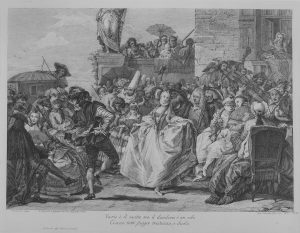
References
Leonardis G, (1765) ‘The Minuet,’ “Plate 10 from Selection of Pictures from Venetian Collections,” OA, The Metropolitan Museum of Art.
Leonardis G, (1765) ‘The Quack Dentist,’ “Plate 9 from Selection of Pictures from Venetian Collections,” OA, The Metropolitan Museum of Art.
VCAA (Victorian Curriculum and Assessment Authority) (2020) VCE History Study Design, VCAA, Victorian Government, accessed 11 July 2022.
2. The fall of the Ming Dynasty: Analysing cause and consequence
Tang Pusen Liu
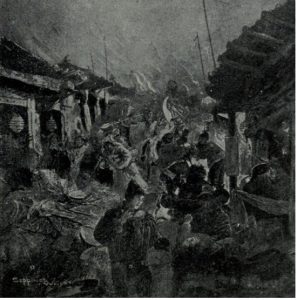
The Jiashen Incident or Battle of Beijing in 1644 (author unknown) via Wikimedia Commons, Public Domain
| Curriculum context | Unit 1 Empires Area of Study 2 (VCAA, 2020) |
| Historical thinking concept/s | Analyse cause and consequence
|
| Historical context | The Outbreak of Peasant Uprising Movements: The decline of Ming dynasty |
| Learning intentions |
|
Activity
Use the following sources and your own research to identify key events that led to the downfall of the Ming Dynasty and then categorise the causes and consequences:
Research prompts
An overview of Late Ming peasant campaign
Why did the Ming explode into chaos?
| Key event/ movement | Impact on Ming society | Impact on Ming political structure/ power | Categorise causes:
Short-term? Long-term? Ideological, political, social, environmental, economic? |
Categorise consequences:
Short-term? Long-term? Ideological, political, social, environmental, economic? Intentional? Unintentional? |
Essay
Use this information to develop an essay plan and essay that addresses the question:
To what extent was the downfall of the Ming dynasty caused by peasant rebellions?
References
Boundless (n.d). Fall of the Ming Dynasty. Boundless World History CC BY-SA: Attribution-ShareAlike
Britannica (n.d.) Li Zicheng Biography, Britannica, accessed 11 July 2022.
Facts and details (2019) Decline of the Ming Dynasty. Facts and details, accessed 11 July 2022.
NZ History (n.d.) Cause and Consequence: Analysis, New Zealand History, accessed 8 September 2022.
NZ History (n.d.) Cause and Consequence: Analysis, New Zealand History, accessed 8 September 2022.
Social Streamers (2021) Why did the Ming explode into chaos? You Tube, accessed 7 September 2022.
VCAA (Victorian Curriculum and Assessment Authority) (2020) VCE History Study Design, VCAA, Victorian Government, accessed 11 July 2022.
3. Investigating the trade-based economy of the Ming Dynasty
Harvey Costigan
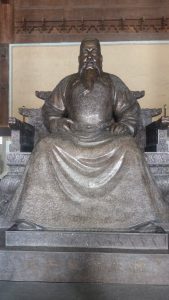
Statue of Emperor Hongwu in Ming tombs by NhacNy2412, Wikimedia Commons (CC BY-SA 4.0)
| Curriculum context | Unit 1 Empires (VCAA, 2020) |
| Historical thinking concept/s | Ask and use historical questions |
| Historical context | International trade > The Ming Empire’s thriving trade-based economy |
| Learning intentions | Identify the key features of the Ming Dynasty’s economy that assisted the empire to become as big and powerful as it was.
Answer and formulate literal, inferential and evaluative questions.
|
Activity
For this activity you will answer questions about the Ming Dynasty’s economy and the changes that were associated with it. In Part A of this activity you will learn how to answer literal, inferential and evaluative questions using the source material as a reference. For Part B of this activity you will swap your work with one of your peers and evaluate each other’s answers, to find areas which you are able to improve on for next time. For the last part of this activity, you will then utilise your knowledge on the features of literal, inferential and evaluative questions to formulate your own questions about the Ming Dynasty economy.
Part A
Question types:
Literal Questions: These questions are identifiable within the text and draw on your understanding of explicit details talked about within the source. (DET 2021)
Inferential Questions: Synthesise an answer to the question by using and interpreting relevant text clues you have found whilst analysing your source. (DET 2021)
Evaluative questions: These questions get you to make a judgement call, using your own knowledge on the topic as well as evidence from the source material. (DET 2021)
Use the source The Role of Foreign Trade to answer the following questions.
Literal questions
- Who was the first emperor of the Ming Dynasty?
- From the mid 15th century onward what was the dominant currency in the Ming Dynasty?
- What did the first emperor believe was basis of the Ming’s economy?
Inferential questions
- Why did Hongwu impose the ‘haijin’ onto the foreign trade industry?
- Why did the population of China rise drastically during the Ming Dynasty period?
Evaluative questions
- Why were China’s relations with Spain considered more successful than their relations with the Portuguese and to what extent were they more successful?
- Evaluate the accurateness and reliability of Mateo Ricci’s Map and discuss the possible limitations of technology back then compared to now.
Part B
Find another person who has also completed the activity. With this partner compare your answers and give constructive feedback to each other on 3 different aspects.
Part C
Once again utilise the source material The Role of Foreign Trade to develop one literal question, one inferential question and one evaluative question that could be answered using the same resource.
References
DET (Victorian State Government Department of Education and Training) (2021) Literacy Teaching Toolkit: Comprehension, DET, accessed 1 August 2022.
Lumen Learning (n.d.) The Role of Foreign Trade, Lumen Learning, accessed 29 July 2022
VCAA (Victorian Curriculum and Assessment Authority) (2020) VCE History Study Design, VCAA, accessed 15 July 2022.
4. Upswing of Ming: Which trading goods gave the Ming dynasty its economical power?
Harvey Costigan
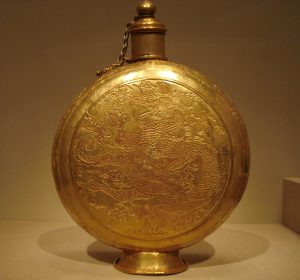
Golden canteen with dragon, Ming Dynasty, Wikimedia Commons (CC BY-SA 4.0)
| Curriculum context | Unit 1 Empires (VCAA, 2020) |
| Historical thinking concept/s | Ask and use historical questions |
| Historical context | International trade > The Ming Empire’s thriving trade-based economy |
| Learning intentions | Identify features of the Ming Dynasty’s economy, specifically looking into the most popular trade goods and inventions.
Frame historical inquiry questions through the utilisation of one’s own knowledge and questioning abilities. Construct an historical argument.
|
Activity
The Ming Dynasty is a very significant period in Chinese history due to the many technological innovations and developments of this era. In this activity you will learn about some of the many different creations of the Ming Dynasty era and the export items at the time.
1. From these resources, you will choose either one of the popular types of traded items or a specific artefact from this period. Now, you will imagine you are a time travelling merchant who has come from the Ming Dynasty period to the present day to sell this item. Create a 250-word informercial about this specific item. Your job is to explain how this item was popularised, what its value was in the period, describe how these items have influenced household items that are in our houses today and the practicality of the item itself.
Some examples include: silk, pottery/porcelain, silver ingots
Utilise the following resources and your own research:
- Source 1: Ming and Qing Dynasties
- Source 2: The Art of the Ming Dynasty
Please do not feel as if you have to read all paragraphs and pages from these resources, flick through and choose relevant sections.
2. Present your infomercial to the class or a partner.
3. You will then develop 3 questions about someone else’s informercial item or artefact. See if you can find out the answers to the questions you receive.
References
Kemp M F, Vick A, Widener N, Toye D, Greenwood N & McCollum A (2021) The Making of Early Modern World 1450-1700 CE, OER Commons, accessed 29 July 2022.
smarthistory (n.d.) The art of the Ming dynasty, smarthistory, accessed 28 July 2022.
VCAA (Victorian Curriculum and Assessment Authority) (2020) VCE History Study Design, VCAA, accessed 15 July 2022.

